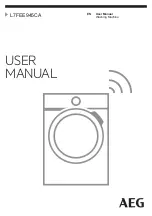
7
ENGLISH
It is important not to connect the vent
hose to, for example, a cooker hood, or
a chimney or flue pipe designed to carry
the exhaust from a fuel burning
appliance.
Note that to avoid condensation problems, it is
essential that the dryer be fitted with the flexible hose
to carry its “exhaust” at least beyond the kitchen
units; preferable outside the kitchen.
In order to prevent the appliance from overheating, it
is important that the steam exhaust is unobstructed.
Therefore, in case of a permanent hose fitted to an
exterior wall or ceiling, it must be ensured an
exhaust capacity of at least 150 m
3
/h.
If the dryer is fitted next to kitchen units, make
sure that the vent hose is not squashed. If the
hose is partially squashed, drying efficiency will
be reduced, resulting in longer drying times and
higher energy consumption.
If the hose is completely squashed, the safety cut-
outs with which the machine is fitted may operate.
Electrical connection
This machine is designed to operate on a 220-230 V,
single-phase, 50 Hz supply.
Check that your domestic electrical installation can
take the maximum load required (2.2 kW), also
taking into account any other appliances in use.
Connect the machine to an earthed socket, in
accordance with current wiring regulations.
The manufacturer declines any
responsibility for damage or injury
through failure to comply with the
above safety precaution.
P0055
Stacking kit
A special stacking kit is available through your
dealer, to enable the mounting of the dryer on top of
your washing machine.
Door reversal
To make it easier to load or unload the laundry the
door can be reversed.
This operation must be carried out by qualified
personnel.
Operate as follows:
- Remove the door by unscrewing the two screws
(1) fastening the hinge to the cabinet (Fig. A).
- Remove the safety catch (2) and the plug (3) by
bending the two fastening tags (Fig. A).
- Refit the safety catch (2) and plug (3) on the door
by reversing their positions (Fig. B).
- Remove the plastic plate (4) by unscrewing the two
fastening screws (Fig. A).
- Refit the plastic plate (4) on the opposite side
(Fig. B).
- Refit the door by screwing in the two screws (1)
which fasten the door to the cabinet (Fig. B).
P0748
B
1
4
2
3
P0283
A
2
3
4
1
P0280
125993430.qxd 9/4/02 8:38 AM Pagina 7






























